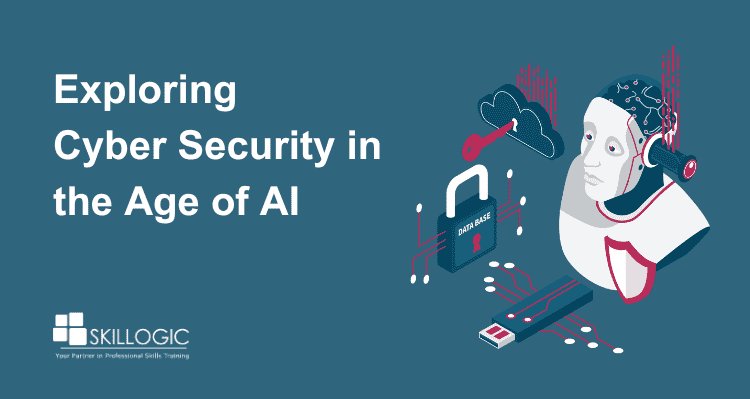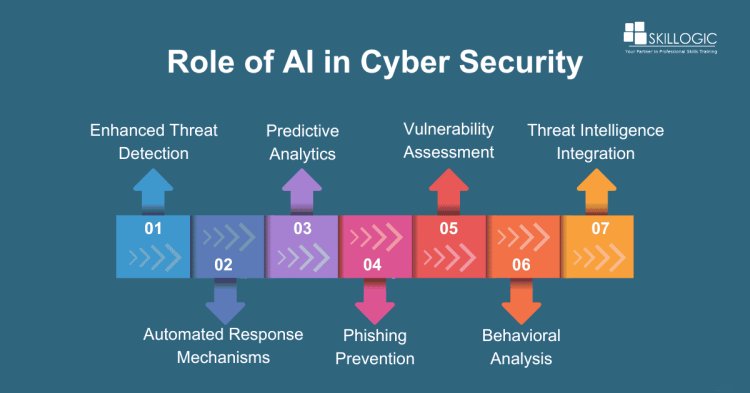Exploring Cyber Security in the Age of AI

In today’s rapidly evolving digital landscape, artificial intelligence (AI) has emerged as a transformative force across various industries, including cyber security. As organizations increasingly rely on AI for enhanced efficiency and decision-making, they simultaneously face a paradoxical challenge: while AI can bolster security measures, it also introduces new vulnerabilities. This blog post explores the intricate relationship between AI and cyber security, highlighting the opportunities and challenges posed by this dynamic interplay.
The rise of cyber threats is a major concern for businesses and individuals. As digital footprints expand, comprehensive Cyber Security training is essential. Understanding AI's impact helps professionals prepare for Cyber Security careers and protect against emerging threats. Here are the key roles of AI in Cyber Security:

The Role of AI in Cyber Security
The Role of AI in Cyber Security is pivotal in transforming how organizations protect their systems. By leveraging machine learning algorithms and predictive analytics, businesses can proactively identify vulnerabilities and respond to threats in real time. This shift from reactive to proactive defense is essential as cyberattacks grow increasingly sophisticated.
- Enhanced Threat Detection: AI algorithms analyze vast amounts of data in real time to identify unusual patterns or anomalies, enabling quicker detection of potential cyber threats and breaches.
- Automated Response Mechanisms: AI can automate responses to known threats, such as isolating affected systems or blocking malicious IP addresses, significantly reducing response times compared to manual processes.
- Predictive Analytics: By utilizing historical data, AI can predict potential future of cyberattacks, allowing organizations to proactively strengthen their defenses before a breach occurs.
- Phishing Prevention: AI tools can analyze emails and messages for signs of phishing attempts, such as suspicious links or unusual sender behavior, helping to protect users from falling victim to scams.
- Vulnerability Assessment: AI can continuously scan systems and applications for vulnerabilities, prioritizing risks based on potential impact and likelihood, ensuring that organizations address the most critical security gaps first.
- Behavioral Analysis: AI systems can learn user behavior patterns to establish baselines. Any deviations from this behavior can trigger alerts, indicating potential insider threats or compromised accounts.
- Threat Intelligence Integration: AI can aggregate and analyze threat intelligence data from various sources, providing security teams with actionable insights and facilitating more informed decision-making regarding security measures.
The integration of AI into Cyber Security strategies not only enhances the effectiveness of security measures but also empowers professionals with tools to navigate complex cyber environments. However, it is vital to ensure that those utilizing these technologies undergo proper Cyber Security training.
Refer these articles:
- Ransomware Attacks: How to Protect Your Organization
- Ethical Hacking vs Cyber Security
- Top Cyber Security Skills
New Cyber Security Challenges Introduced by AI
While Artificial Intelligence (AI) is enhancing Cyber Security capabilities, it also introduces new challenges that organizations must address. Here are some of the key Cyber Security risks associated with AI:
- AI-Powered Cyber Attacks: Cybercriminals can use AI to launch more sophisticated attacks. AI can be employed to automate phishing campaigns, identify system vulnerabilities, or create more evasive malware, making it harder for traditional defenses to keep up.
- Data Poisoning: AI systems rely on large datasets for training. Attackers can manipulate these datasets, introducing false or misleading information (data poisoning), which can skew AI models and lead to incorrect threat detection or malicious actions.
- Adversarial Attacks: In adversarial machine learning, attackers deliberately input deceptive data designed to mislead AI systems, causing them to misclassify or overlook threats. This technique can undermine the accuracy of AI-driven Cyber Security tools.
- AI Model Exploitation: Attackers can reverse-engineer AI models used in Cyber Security defenses to understand their decision-making processes. This knowledge can help attackers tailor their techniques to bypass detection and exploit weaknesses.
- AI Weaponization: Cybercriminals may develop AI-driven malware that autonomously adapts and evolves to evade detection over time. These self-learning attacks could outpace human-driven response efforts, posing a significant threat to organizations.
- Ethical and Privacy Concerns: The extensive use of AI for monitoring and detecting threats raises concerns about privacy. AI systems often require access to large amounts of data, including sensitive personal information, increasing the risk of misuse or abuse.
- Lack of Explainability: Many AI algorithms, particularly deep learning models, are "black boxes" that provide limited insight into how they arrive at decisions. This lack of transparency can make it difficult to trust AI-generated threat alerts or to debug and fix errors in Cyber Security systems.
- Dependency on AI: Over-reliance on AI for Cyber Security may lead to complacency, where organizations neglect human oversight or traditional security measures. AI systems are not infallible, and human intervention is still crucial for managing complex or novel cyber threats.
While AI offers powerful tools for enhancing Cyber Security, it also introduces unique risks. As AI continues to evolve, organizations must stay vigilant, balancing the adoption of AI-driven defenses with strategies to mitigate the new Cyber Security challenges it introduces.
Emerging Threats in the Age of AI
The integration of AI into various sectors is creating new and sophisticated cyber threats. Here are some key emerging threats in the age of AI:
AI-Driven Cyber Attacks
Cybercriminals are using AI to automate and enhance cyberattacks, such as phishing, malware creation, and vulnerability exploitation. AI enables faster, more precise, and adaptive attacks that can evade traditional defenses.
Deepfakes and Misinformation
AI-generated deep fakes can create convincing fake videos, audio, and images to impersonate individuals, spread disinformation, or commit fraud. These can be used for social engineering, blackmail, or political manipulation.
AI-Powered Botnets
AI-controlled botnets can operate autonomously, adjusting tactics in real-time to evade detection. These botnets can be used to launch large-scale Distributed Denial of Service (DDoS) attacks or mine cryptocurrencies, making them harder to combat.
Adversarial AI Attacks
Attackers can manipulate AI models by introducing adversarial inputs—subtle changes in data that confuse or mislead AI systems. This can undermine the security of AI-based applications like facial recognition or threat detection.
Autonomous Hacking Tools
AI can be weaponized to create self-learning malware and autonomous hacking tools that continuously evolve, adapting to new defenses and vulnerabilities without human intervention.
AI in Social Engineering
AI can analyze vast amounts of data to craft highly personalized and convincing social engineering attacks, making phishing and identity theft more effective and difficult to detect.
Privacy Violations
AI’s ability to process and analyze large datasets poses a risk to personal privacy. AI tools can be used to de-anonymize data, extract personal details, or predict user behavior, leading to identity theft or unauthorized surveillance.
AI Bias Exploitation
Attackers can exploit biases in AI algorithms to target systems in discriminatory ways, taking advantage of security flaws in systems designed for predictive policing, hiring, or financial services.
As these threats evolve, it is crucial for professionals in the Cyber Security field to stay informed through continuous education and training. Enrolling in a top Cyber Security course can provide valuable insights into the latest trends and tactics used by attackers.
Refer these articles:
The Need for AI-Specific Cyber Security Protocols
As artificial intelligence (AI) integrates deeper into cyber security, traditional security protocols are proving inadequate against the unique challenges posed by AI. The evolution of AI-driven threats necessitates the development of specific protocols tailored to mitigate associated risks.
Why Traditional Protocols Are Insufficient
Traditional Cyber Security measures are primarily reactive, designed to address known vulnerabilities. However, AI introduces complexities that require adaptive strategies:
- Dynamic Threat Landscape: AI-driven attacks evolve quickly, using methods that existing frameworks may not recognize.
- Complex AI Systems: AI algorithms can be vulnerable to adversarial attacks, which traditional security measures might overlook.
Key Components of AI-Specific Cyber Security Protocols
To effectively combat AI-related threats, organizations should implement the following key components:
- Robust Data Management: Ensure data integrity and quality control to protect against data poisoning.
- Regular Model Audits: Conduct vulnerability assessments and compliance checks to maintain secure AI systems.
- Incident Response Planning: Develop tailored response strategies for AI-related breaches and foster cross-disciplinary teams.
- Ethical AI Guidelines: Establish responsible AI use and actively mitigate biases in algorithms.
- Collaborative Defense Mechanisms: Share threat intelligence with industry partners to strengthen collective security.
AI-specific Cyber Security protocols are crucial to address the distinct vulnerabilities and threats posed by AI technology. Implementing these protocols will ensure the security, transparency, and ethical functioning of AI systems, protecting against both AI-powered attacks and vulnerabilities within AI itself
Refer these articles:
- How to Become a Cyber Security Expert in Hyderabad
- How to Become a Cyber Security Expert in Bangalore
- How to Become a Cyber Security Expert in Chennai
The Future of Cyber Security In an AI-Driven World
Looking ahead, the intersection of AI and Cyber Security will shape the future of digital security. Organizations must adapt to the evolving landscape to ensure robust protection against potential threats.
Predictions for the Future:
- Increased Automation: Automation will play an even greater role in cyber security, with AI handling routine security tasks. This will free up human resources for more strategic decision-making.
- Integration of AI Ethics: As AI technology evolves, ethical considerations will become increasingly important. Organizations will need to establish guidelines for the responsible use of AI in cyber security.
- Focus on Human-AI Collaboration: The future of Cyber Security will emphasize the collaboration between humans and AI systems. Professionals trained in both fields will be invaluable in bridging the gap between technology and strategy.
To prepare for these changes, aspiring Cyber Security professionals should consider enrolling in a Cyber Security Certification course. This training will equip them with the knowledge and skills needed to thrive in an AI-driven security landscape.
In conclusion, the intersection of AI and Cyber Security presents both opportunities and challenges. As technology advances, staying informed and adaptable is essential. Investing in education, such as enrolling in a top Cyber Security institute, is key to securing a successful career in Cyber Security and protecting organizations in an increasingly digital world.
At SKILLOGIC Institute, we understand the essential role that Cyber Security tools have in today’s digital landscape. Our Cyber Security Professional Plus Course is carefully crafted to provide learners with the critical skills required to proficiently use a range of Cyber Security tools and address distinct challenges in the field. Accredited by esteemed organizations like IIFIS and NASSCOM FutureSkills, this program offers comprehensive training that incorporates real-time projects and exclusive practice labs. This hands-on approach ensures that participants not only become proficient with these tools but also develop a deep understanding of how to implement them to protect systems from potential threats.
With a thriving community of over 100,000 empowered learners, SKILLOGIC is committed to enhancing careers in Cyber Security through high-quality education and practical skills. With a focus on real-world applications and industry-recognized certifications, we are the preferred choice for professionals aiming to excel in the dynamic field of cyber security. Join us to acquire the knowledge and expertise needed to effectively navigate the landscape of essential Cyber Security tools.

0
119